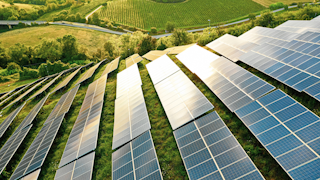With effect from 1 July 2025 a new provision regulating when the development of solar power plants requires a license entered into force
Previously, the construction of solar power plants required a license under the Energy Act where the developer or the local grid company had to install high-voltage equipment (voltage above 1 kV) to connect the plant to the grid. However, with effect from 1 July 2025 a new provision regulating when the development of solar power plants requires a license entered into force. Onshore solar power plants with an installed capacity below 10 MW are no longer subject to licensing; such projects are to be handled by the municipality in accordance with the Planning and Building Act.
For solar power projects with installed capacity exceeding 10 MW, the current regulatory framework will remain in force. All entities that submitted a concession application to NVE before 1 July 2025 may have their application processed by NVE irrespective of installed capacity.
From 1 January 2026, an obligation to extend the grid (Nw: “henteplikt”) is introduced for area licensee (nw: områdekonsesjonær) for connecting production facilities to grid up to and including 22 kV. This means the grid company must build grid facilities to a suitable interconnection point at new power production plants. The change will be particularly significant for solar power plants, as those under 10 MW will not need to apply for a separate license for the grid facilities required to connect to the grid.
Below is a summary of the different steps in the licensing process as of today. The NVE guidance is available in full here (in Norwegian).
- Pre-application project development: Before submitting a license application to NVE, it's important that landowner conditions are clarified. The developer must, among other things, secure the necessary landowner rights to the project area. Early contact with local and other relevant authorities, such as the municipality, County Council, and County Governor, is also recommended. Early confirmation of sufficient grid capacity in the intended project area is crucial, as NVE will not process a concession application in cases of insufficient or uncertain grid capacity.
- Notification obligation and impact assessment: Previously, there was no requirement for prior notification (Nw: forhåndsmelding) for a project proponent before submitting an application for a facility license. As of 1 July 2025, the Regulation on Impact Assessments stipulates a notification requirement for solar power plants with an installed capacity exceeding 10 MW.
This means that, at the earliest possible stage of the project, a notification containing a proposed impact assessment programme must be prepared. The notification must include a description of the project, an account of the anticipated impacts, and a proposal for an impact assessment programme. The notification, together with the proposed programme, shall be submitted for public consultation before being adopted by the competent authority. - Application consultation round: After the license application is received, NVE will send the application for consultation to relevant hearing bodies. The application will also be made public in local newspapers so that interest groups and the general public can provide input. In some cases, public meetings might be organized. If, during the hearing, it becomes clear that the knowledge base is insufficient, NVE can request the developer to provide additional studies or supplementary information.
- The NVE’s evaluation and decision: NVE will then process the application based on the application, impact assessments, hearing statements, and their own expertise in solar power. The result of NVE's treatment can either grant a concession to build solar power or decline the application. Specific conditions for the permission will be determined in the construction concession. Further details are set out in the detailed plan.
- Administrative appeal processes: Anyone with a legitimate interest in appealing can appeal NVE's decision to the Ministry of Energy (ED) for a final decision.
- Conditions, follow-up, and supervision: The developer must prepare a detailed plan for the facility, describing the final construction solution for the solar power plant, all land interventions, and how landscape and environment will be preserved during the construction and operational phases. This detailed plan must be approved before construction can begin. NVE will monitor the construction and operational phases to ensure that conditions are met. In addition to the construction concession and approved detailed plan, it's also necessary to clarify the relationship with municipal plans, grid connection, and possibly obtain other public permits. Furthermore, the developer must secure the necessary private law rights before construction can begin. Especially important is the right to use land areas. If it is not possible to make agreements with all affected landowners, rights must be expropriated, and a legal assessment must be held for the determination of compensation.
Please do not hesitate to get in touch with us if you would like to know more about our role in facilitating solar energy and the opportunities available in this market.
Spotlight
Renewable energy projects towards 2030
Norway will need more renewable energy to succeed with the green shift and reach its target of reducing greenhouse gas emissions by 70-75 percent by 2035, compared to 1990. We invite you to learn more about our role in making sure future renewable development projects are successful.
Read more




